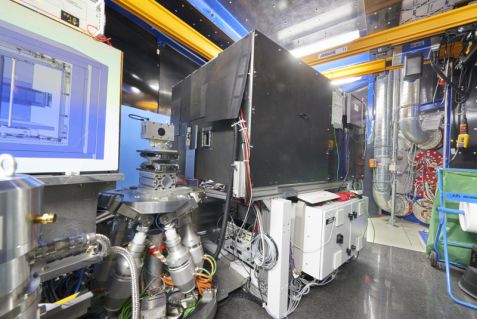MLZ is a cooperation between:
 > Technische Universität München
> Technische Universität München > Helmholtz-Zentrum Hereon
> Helmholtz-Zentrum Hereon
 > Forschungszentrum Jülich
> Forschungszentrum Jülich
MLZ is a member of:
 > LENS
> LENS > ERF-AISBL
> ERF-AISBL
MLZ on social media:

MLZ (eng)
Lichtenbergstr.1
85748 Garching
04.03.2016
Self-diffusion in amorphous silicon

In the reflectometer MARIA the vertically focused neutrons of the collimation reach the sample, manipulated by the hexapod, from left to right and are scattered from there to the detector arm. © W. Schürmann / TU München
Scientists of the Technical University of Clausthal succeeded the first time using neutrons at FRM II and the PSI to measure the self-diffusion in amorphous silicon.
This phenomenon describes the temperature-dependent statistical movement of the silicon atoms and the underlying defects. For instance, structural changes can be understood or described as mechanical deformations on the atomic level. In crystalline silicon, which plays a dominant role for decades in information technology, the self-diffusion has been repeatedly characterized by various methods over a wide temperature range. The disordered amorphous phase of silicon is not very stable, which had been made the measurement of the atomic movements very difficult.
To still be able to follow the atomic movements on a few nanometers’ scale, the scientists of Professor Harald Schmidt’s team of the Institute of Metallurgy of the Technical University of Clausthal used neutron reflectometry. For this they piled successive amorphous silicon layers with natural isotope content and such enriched with the stable isotope 29 Si in a few nanometers thickness. This creates structures from 20 alternating monolayers. At temperatures of 550 to 700 °C the isotopes mix, but are clearly distinguishable by neutrons. This leads to a change in contrast in the scattering length density and thus to a small but measurable change in intensity of the scattered neutrons.
The measurements were carried out both at the reflectometer MARIA of the Heinz Maier-Leibnitz Zentrum in Garching place and at the reflectometer AMOR of the Paul Scherrer Institute in Switzerland.
The theory suggests that in the disordered structure of amorphous silicon atoms move much faster as it is known at the same temperatures for crystalline silicon. In fact, the measurements at 700 °C showed a diffusion coefficient which exceeds the measured in the crystalline silicon by five orders of magnitude. Previously, theorists and experimenters blamed a dangling bond of a threefold coordinated silicon atom.
Florian Strauss, who planned and carried out these measurements for his doctorate, came to a different conclusion: “We have shown that a rather high activation energy of 4.4 eV is required for that. The amorphous silicon is therefore a much more complex material than previously thought. “The results are suggested to a diffusion mechanism, which is dominated by defects extended over several nanometers. These measurements are indeed basic, but still interesting for other systems, especially silicon-lithium compounds, as they occur for example on battery materials.
Original publication:
F. Strauß et al., Self-Diffusion in Amorphous Silicon, Phys. Rev. Lett. 116, 089903 (2016)
MLZ is a cooperation between:
 > Technische Universität München
> Technische Universität München > Helmholtz-Zentrum Hereon
> Helmholtz-Zentrum Hereon
 > Forschungszentrum Jülich
> Forschungszentrum Jülich
MLZ is a member of:
 > LENS
> LENS > ERF-AISBL
> ERF-AISBL
MLZ on social media:


